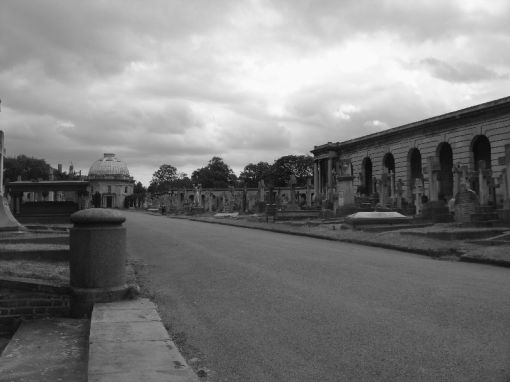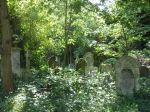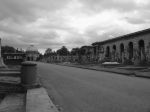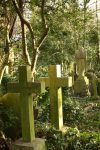 I am not sure what it is about cemeteries that fascinates me so much. It certainly has no morbid roots at all. Maybe it is the differences in the traditions between various cultures, like the grand tombstones and statues in Parisian cemeteries versus the colourful above ground plots throughout Latin America. Wherever I travel to, visit a major cemetery is always on the to-do list.
I am not sure what it is about cemeteries that fascinates me so much. It certainly has no morbid roots at all. Maybe it is the differences in the traditions between various cultures, like the grand tombstones and statues in Parisian cemeteries versus the colourful above ground plots throughout Latin America. Wherever I travel to, visit a major cemetery is always on the to-do list.
This especially goes for England, home to some of the most beautiful cemeteries I have seen. Most English cemeteries are separated into a new and an older section, the former usually less interesting than the latter. The older tombstones offer countless things to discover, interesting inscriptions which inspire me to wonder about the lives of the people and their families, beautiful sculptures, famous people…
London in particular has beautiful cemeteries rich in history and beauty and shrouded in mystery and wonder. Here are my top 5 both for visitors to this great metropolis, and for Londoners, too, plus a 32 image gallery of beautiful photos by photographer, Mariposa!
1. Abney Park, Stoke Newington
This Stoke Newington-based cemetery is by far my favourite. Abney Park was the only cemetery where no divisions were made between people of different religious backgrounds and the chapel was the first in Europe to serve for all non denominational burials, built in a style that is known as “Dissenting Gothic”.
The 32 acre park (129,000 m²) dates from just before 1700 and was laid-out by the first Lady of the Manor of Stoke Newington, the Independent Lady Mary Abney.
It was unique in being the first arboretum – with its approximately 2,500 trees and shrubs – to be combined with a cemetery in Europe, offering an educational attraction that was originally set in a landscape of fields and woods. The original trust cemetery was sold to a commercial company in the 1880s, who ran it for almost a hundred years until it closed in 1978. 200,000 burials took place in Abney Park Cemetery while it was in use.
Closed now to new burials, its gravestones and sculptures become increasingly decayed. Rather than detracting from the beauty of Abney Park, it is just this decay and the wild nature of it, that creates the charm of this cemetery. Countless trees, bushes, weeds, flowers and vines wrap themselves around the sculptures and tombs so that you feel as though you are in an enchanted forest creating a mysterious, yet romantic feeling. You could spend hours exploring the large number of intricate paths that curl through along the ancient graves.
Interesting trivia about Abney Park: Rumour has it that an unexploded Second World War bomb is located somewhere within the cemetery.
The cemetery and the chapel were used for the funeral scenes of Amy Winehouse’s “Back to Black” music video.

You might recognise this cemetery located in Chelsea, West London, as it is a Hollywood film star. Brompton Cemetery has been featured in several films, nabbing the most screen time in the recent Sherlock Holmes film.
Brompton was opened in 1840 on 39 acres of land, and as part of the Magnificent 7, a number of Victorian cemeteries that were built in the 19th century in London after the city’s population exploded from 1 million to 2.3 million. Before that, the dead were buried in churchyards. These became overcrowded, and so a bill was passed to create private cemeteries. These were known as the Magnificent 7, all constructed within 10 years.
One of the most metropolitan burial grounds in London, Brompton sits between Fulham Road and Old Brompton road, two of west London’s busiest. Pass through the gates, however, and Brompton is a green inner-city oasis of peace and quiet. Rather than a place of mourning, this cemetery is a popular public space for dog-walkers, cyclists, joggers and is a hub of (respectful) activity.
The layout of the cemetery feels almost Greco-roman, a very distinguished layout of a narrow, long semi-circular shape with a central avenue leading to a colonnade and chapel in the centre. Catacombs can be found underneath the colonnades and a thousands upon thousands of beautiful sculptures, headstones and mausoleums can be discovered throughout the property.
Pay attention and look carefully for the dozens of photographers throughout the cemetery, pointing their lenses at the unique and intriguing photo opps unlike any other in London, whilst aspiring and established writers ponder their prose on many a bench throughout Brompton as well. In fact, Author Beatrix Potter used the gravestones in Brompton Cemetery as a source for her character names – such as Mr Nutkin, Mr McGregor and Tommy Brock. The most famous tombstone here is that of Emmeline Pankhurst – a leading Suffragette who fought to win women the vote.
Undoubtedly London’s most famous cemetery and home to the tomb of Karl Marx, Highgate Cemetery is located on 37 acres of land and is home to 52,000 graves (which hold 167,000 people).
Located on a steep hillside in the North London village of Highgate, the cemetery is divided into two parts, the eastern and the western side. The western part is the oldest section with many fascinating Victorian gravestones and mausoleums and can only be visited in a guided tour (₤7), while the eastern side can be visited at your leisure for ₤3. It seems fitting that the less expensive, more egalitarian eastern side would be home to the colossal tomb of the father of communism, Karl Marx. While the rest of this section plays second fiddle to the guided tour on the other side of the street, Marx is a must-see.
The difference between newer and older sepulchres is immense – some of the Victorian graves are almost completely covered by bushes, parts of the headstones have been destroyed by weather, wind and time, and the modern graves offer some very interesting artistic creations.
Some interesting trivia – Audrey Niffenegger, author of the best-selling novel, Time-traveler’s Wife, made Highgate Cemetery location of her second novel, Her Fearful Symmetry and worked as a tour guide while she was researching for her book.
These two adjacent cemeteries, originally called Lewisham and Deptford, were opened in 1858, separated by a wall until 1948. Renamed Ladywell & Brockley, these ‘twin cemeteries’ are now technically a single cemetery.
London might be limited in terms of free space, but its cemeteries stretch far and wide. Ladywell & Brockley is a good one to visit with a bicycle and ride through it’s 37 acres in South London. The cemetery is a haven for beautiful birds, flowers and other plant life, and is a place that, despite what you might think, is very much ‘alive’ in terms of nature.
Being deep down in the south east of London, L&B is not swamped with tourists, though its tombstones hold equally fascinating histories of their inhabitants. Take your time to discover these histories, such as the murder case of a 17-year-old girl and hints of Deptford’s seafaring history.
5. Cemetery of All Souls, Kensal Green
Kensal Green is the oldest of the Magnificent 7 and was used as a paradigm not only for cemeteries within Great Britain but also cemeteries as far as Australia, although it was inspired by the Parisian cemetery Pere-Lachaises, one of my all times favourites. You can see the similarities between the Parisian one and All Souls, though Pere-Lachaises is a decidedly more magical place to visit.








































Fascinating! and beautiful pics as well.
Excellent choices. I haven’t been to all of them but I will sure I do now. I’m aprticulalry interested in visiting Abney park.
Joe
Kensal Green is amazing, my favourite victorian cemetery